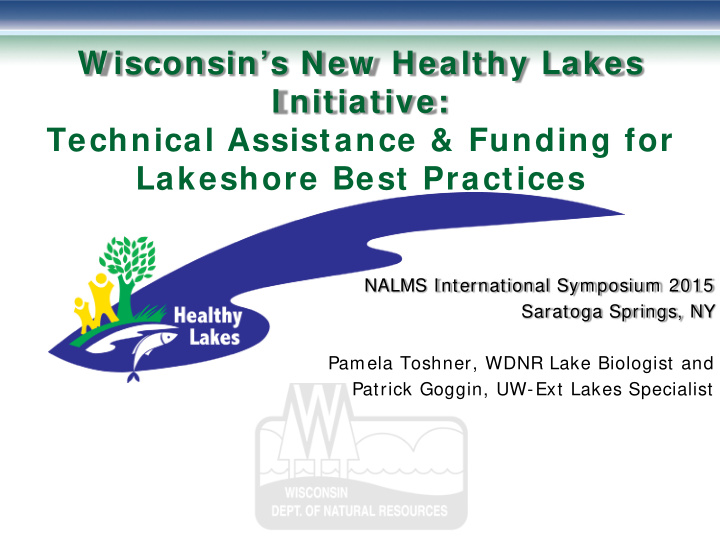



W isconsin’s New Healthy Lakes I nitiative: Technical Assistance & Funding for Lakeshore Best Practices NALMS International Symposium 2015 Saratoga Springs, NY Pamela Toshner, WDNR Lake Biologist and Patrick Goggin, UW-Ext Lakes Specialist
Today’s Presentation • Background • Healthy Lakes Overview – Best Practices – Grants • Lessons Learned • Resources
$2.3B Background
Background Healthy Lakes Team THANK YOU to everyone who provided feedback, including the many partners who completed a customer survey and commented during the public review of proposed DNR guidance. Additional contributors include: Cheryl Clemens, Karen Engelbretson, John Haack, Dave Kafura, Amy Kowalski, John Kriva & ERC, Jesha LaMarche, Eric Olson, Flory Olson, Tim Parks, Bret Shaw, Shelly Thomsen, Scott Toshner, Bone Lake Management District, Maine Lake Smart Program, and Vermont Lake Wise Program.
Background Lean Government Charter Goal: protect and improve the health of Wisconsin lakes by increasing lakeshore property owner participation in habitat restoration and runoff and erosion control projects. 80% 70% Response 60% 50% 40% 30% 20% 10% 0% Essential Nice to have Unnecessary Unfamiliar
Overview Wisconsin’s 2014-2017 Healthy Lakes Implementation Plan Fact Sheets Technical Guidance Statewide Plan • 5 Best Practices • More project • Implementation installation detail • Funding & Admin focus FAQs
Overview Wisconsin’s 2014-2017 Healthy Lakes Implementation Plan Do it yourself Apply for Healthy Lakes Grant funding Integrate into local Green Lake, Green Lake County (Lisa Reas) planning efforts
Overview Wisconsin’s 2014-2017 Healthy Lakes Implementation Plan Healthy Lakes project participation is voluntary.
Best Practices Not for complex sites where engineering design/ review is necessary. Photo: Vilas County Land & Water Conservation Department
Best Practices Practice # 1: Fish Sticks
Best Practices Practice # 1: Fish Sticks Pewaukee Lake, Waukesha County (Tom Koepp) • Commit to no-mow or 350 ft 2 native planting at the base
Best Practices Practice # 2 : 350 ft 2 Native Plantings
Best Practices Practice # 3: Diversion Broad- based dip (http://awwatersheds.org/)
Best Practices Practice # 4: Rock Infiltration Deer Lake, Polk County (Cheryl Clemens)
Best Practices Practice # 5: Rain Garden Shell Lake, Washburn County (Brent Edlin)
Grants Healthy Lakes Grants • $1000/best practice funding cap • $25,000 grant cap – eligible sponsor applies on behalf of individual landowners • 2-year grant agreement and 10-year individual landowner contract
1 1 applications 8 counties 1 5 lakes 4 8 properties 1 0 0 practices $81,540.54 state $126,667 total
Lessons Learned “ I t ’ s s t i l l n o t s i m p l e . ” First “official” Healthy Lakes project participant’s site
Lessons Learned Tech it up.
Lessons Learned Collateral partners. Cloverleaf Lakes, Shawano County
Lessons Learned A few native planting glitches. Village of Frederic, Coon Lake, Polk County
Lessons Learned C i t i z e n s l e a d , a n d g o v e r n m e n t f o l l o w s .
Resources • www.healthylakeswi.com • Pro Shoreland Habitat Training (1: 30 today) • Future workshops CONTACTS dferris@burnettcounty.org Dave Ferris Burnett County (715) 349-2186 Pat Goggin UW-Ext Lakes (715) 365-8943 pgoggin@uwsp.edu Jane Malischke WDNR (715) 635-4062 jane.malischke@wi.gov Tom Onofrey Marquette County (608) 267-3036 tonofrey@co.marquette.wi.us carroll.schaal@wi.gov Carroll Schaal WDNR (608) 261-6423 pamela.toshner@wi.gov Pamela Toshner WDNR (715) 635-4073
Recommend
More recommend